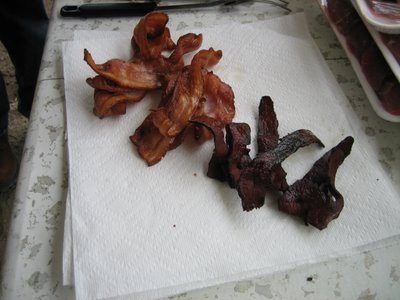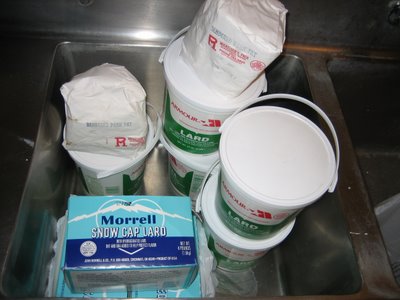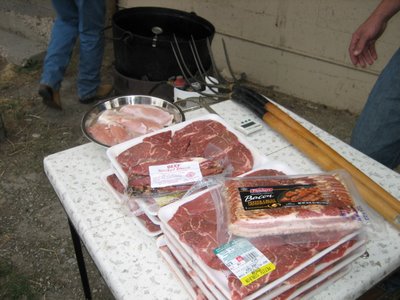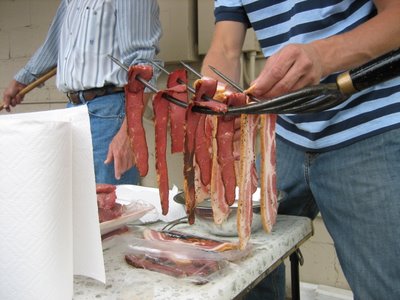What happens when you combine a vat, propane tank, lard, pitchfork, and several cases of beer?
In my family, the answer is ‘a good time’ that is also known as Pitchfork Fondue.
For over a decade, Pitchfork Fondue has been a staple at many of our family gatherings. And let me tell you, nothing brings a family closer together than a vat of boiling lard (and lots of beer).
Pitchfork Fondue is a pretty simple process. A couple dozen pounds of lard are brought to boil in a vat that has been placed on a flame fueled by propane gas. The food being cooked – whether it be meat or battered vegetables or whatever – is hung on the tips of a pitchfork (preferably a clean one that hasn’t previously been used for some other barnyard activity). The pitchfork is then dipped into the vat of lard for whatever amount of time is necessary to cook the particular food item (usually no more than a couple minutes tops). This method not only cooks the food quickly, but it also enhances the flavors of the food in a way that is much different than traditional grilling.
And let’s face it, the best thing about Pitchfork Fondue is that it is just plain fun to do.
(And just to clarify…the beer really isn’t part of the cooking process, but it’s definitely an important part of the experience.)
The relatives of mine who own a Pitchfork Fondue apparatus live in a small farming town called Terreton in Eastern Idaho. As kids, we used to go to Terreton for a week each year to hang out on their sheep ranch (yep, we didn’t spend Spring Break at the beach or camping, we spent it on a sheep ranch…and it was actually fun). A couple weeks ago, I went back to Terreton for the first time in many years for my aunt and uncle’s 50th wedding anniversary. Knowing that Pitchfork Fondue would be making an appearance at the party, I placed a special request with my cousin Rob – our family’s Pitchfork Fondue Chef de Cuisine – to see if we could experiment with frying bacon in the vat, something we surprisingly haven’t experimented with before.
I arrived in Terreton the Friday night before the party. Since most of our family was coming to town for the weekend and sleeping accommodations at my relatives’ two homes were tight, my cousins had rented the bed and breakfast in town for me and my siblings (and I use the term “bed and breakfast” loosely).
As I mentioned before, Terreton is a small town. Between Terreton and the nearby town of Mud Lake, there are less than 500 residents in the area. So there is only one grocery store in town. Or I should say, there used to be only one grocery store in town. Apparently the previous store owners couldn’t justify keeping the business open any longer, and the store recently closed. The building has since been remodeled into an event hall with sleeping accommodations in the basement (or the “Silence of the Lambs Room” as my brother calls it). Hence the “bed” part of the B&B. And the event hall has a kitchen that guests can use to prepare meals for themselves. That takes care of the “breakfast” part of the B&B. So there is no longer a grocery store in Terreton, but there is a self service B&B. Go figure!
However, we prefer to just tell everyone we slept at the grocery store because it is more fun to say.
(Conveniently for us, the grocery store would also be the site of the anniversary party the next day. Coors Light + not having to drive = Lauer sibling gluttony.)
Despite the cool, wet weather, we all gathered around the vat with our first round of beers at about noon on Saturday and watched the lard begin to melt (passing the time, Idaho-style). When the temperature reached 350 degrees, Rob began to cook. Steaks and chicken were on the menu, in addition to pepper crusted bacon and beef bacon. Given that there was a large crowd in attendance, most of whom were not there for bacon, Rob cooked several rounds of beef and chicken first. After everyone had been served their main course, we began to experiment with the bacon.
For the first round, we filled half of the pitchfork with pork bacon and the other half with beef bacon. Rob dipped it in the vat for about 45 seconds. This was the perfect amount of time for the beef bacon. The lard brought out the saltiness of the beef bacon much more than cooking it in an oven does, and it was mindbogglingly delicious. The pork bacon needed just a bit longer to reach a desirable level of crispiness (1 minute was good), which we achieved on the second round. Regardless of how you normally like your pork bacon cooked, it needs to be cooked to a very crispy level using the Pitchfork Fondue method in order to reach its full taste potential.
Both bacons turned out to be really good when cooked as Pitchfork Fondue, but I reluctantly admit that I think the beef bacon was better in this particular situation. And even though some people at the party initially thought we were crazy to cook bacon in a vat of boiling lard, every single person who tried it loved it and many kept coming back for more. It was impossible to walk across the room with a tray full of bacon and reach the other side with any bacon left.

Pitchfork Fondue Bacon. A true Idaho delicacy.




